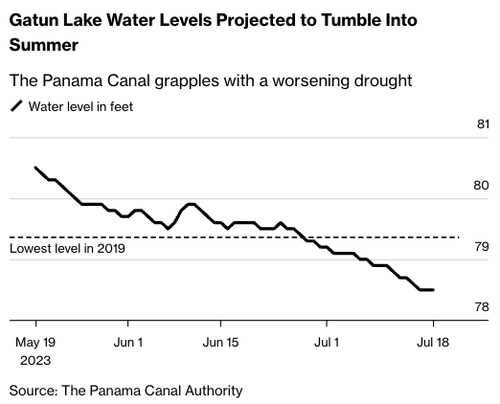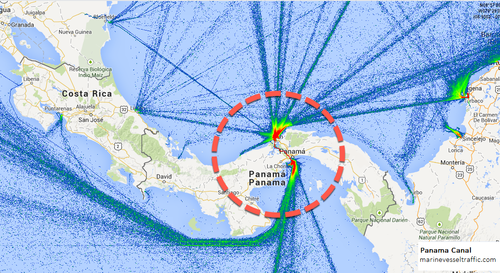Due to severe drought, authorities at the Panama Canal are set to impose new draft restrictions in the coming days. These rules, affecting one of the world's most crucial maritime routes, will force vessels to reduce cargo weight and incur higher fees.
Bloomberg cited canal spokesperson Octavio Colindres who said neo-Panamex container ships seeking to cross the canal that connects the Atlantic and Pacific Oceans must comply with a maximum depth of up to 44.5 feet, down from 45 feet. This will force vessels to haul less cargo or otherwise transport fewer goods.
Panama Canal Ship Traffic
Colindres said a draft restriction of 44 feet would be imposed by the end of the month. A 50-foot draft is considered average for the canal during normal weather conditions, though a recent drought has left Lake Gatun, the largest of two lakes that feed the canal, with extremely low water levels.

Around 6% of all global maritime traffic passes through the canal, mainly from the US, China, and Japan. During the 2016 and 2019 droughts, the draft limit went as low as 43 feet.
Perhaps the onset of El Niño, a weather pattern that brings drier conditions across much of Central America, is partially responsible for arid conditions, which might worsen as the Northern Hemisphere summer is less than 30 days away.
"The lower-than-usual water levels in the Gatun Lake are causing severe draft restrictions on vessels transiting the Panama Canal," shipper Hapag-Lloyd told customers in recent weeks. The advisory was directed towards vessels traveling from East Asia to North America that must pay a surcharge after June 1 to traverse the canal.
Bloomberg warned of a possible shipping disruption if canal water levels continued to drop:
LNG carriers, which are highly dependent on the canal, are not as affected by the draft changes because the vessels have fewer draft restrictions than those carrying heavier industrial goods or commodities. But any bottlenecks are a cause for worry considering that US LNG export expansions are due to come online in the next five years.
Bloomberg added:
Asia-to-US cargo can take alternative routes through the Suez Canal. Or they can use ports in southern California, which would involve loading containers onto trucks or trains bound for Midwest and East Coast population centers.
And what's to say, if the dry weather pattern continues, a vessel might be more prone to grounding, which could disrupt maritime traffic. Either way, less cargo will be flowing through the waterway due to draft restrictions.
Well, Greta, Panama Canal could use some of this melting water you described would drown the world...
https://www.zerohedge.com/commodities/panama-canal-hit-shipping-restrictions-water-crisis-set-worsen

No comments:
Post a Comment
Note: Only a member of this blog may post a comment.